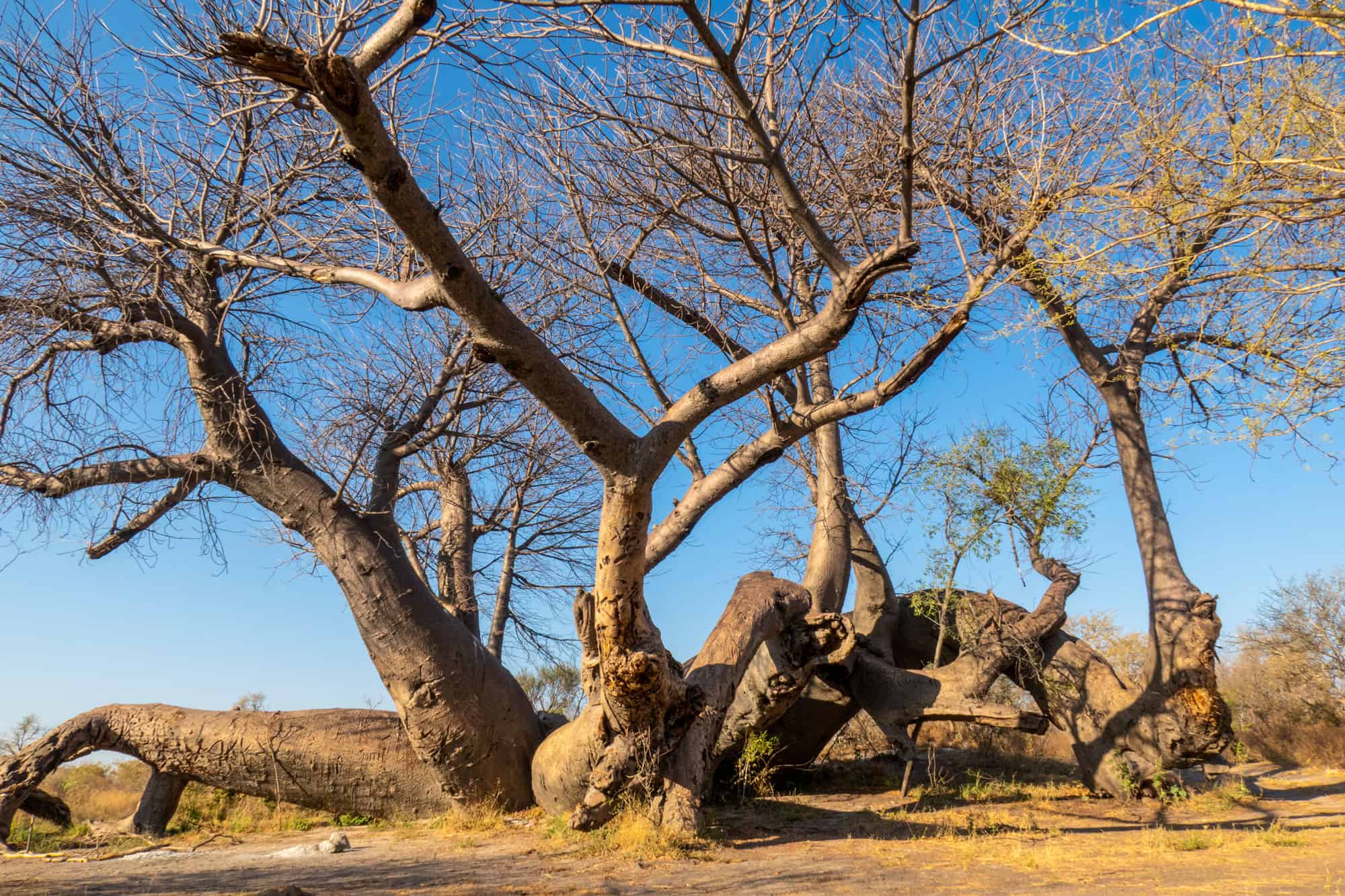Namibia is a country with breathtaking flora and fauna. Despite its dry climate, it’s packed with life that’s adapted to suit its climate and environment. Let’s take a closer look at some of the incredible trees native to Namibia.
But first, where is Namibia?
Where is Namibia?
The Republic of Namibia is a country in Southern Africa. It borders the Atlantic Ocean, Botswana, Zambia, Angola, and South Africa. 200 meters across the Zambezi river lies Zimbabwe.
Namibia won its independence from South Africa in 1990 and it’s capital city is Windhoek. 2.55 million people live in Namibia with astonishing wildlife such as the endemic gemsbok antelope, numerous elephants and the largest population of cheetahs in the world.
Namibia is the driest country in sub-Saharan Africa. It’s named after the Namib desert, which experts think might be the oldest desert in the world and at least 55 million years old. The country only receives a mean average of 278 mm of rainfall each year and that means the majority of its native trees are tough, water-storing plants, but there are rivers where different types of trees thrive too.

Namibia means “vast place.”
©Nate Hovee/Shutterstock.com
1. Ana Tree (Faidherbia albida)
The ana tree is a thorn tree with deciduous blue-green leaves that fall in summer when water is scarce. It’s usually found along the river banks of the central plateau regions alongside rivers such as the Swakop.
Antelope and elephants graze its foliage and its yellow-white flower inflorescences that emerge in spikes and mature into red fruit pods that resemble apple peelings. Even though the ana tree has cream-colored two centimetre long thorns, it’s an essential resource for many mammals, birds, and insects.
Young trees have smooth and slender trunks. As they age and reach up to 82 feet (25 meters) tall their gray-brown bark breaks away in blocks. Locals only use the wood to light fires and in traditional medicine infuse its bark to treat coughs and respiratory illnesses.
Ana trees are protected in Namibia.
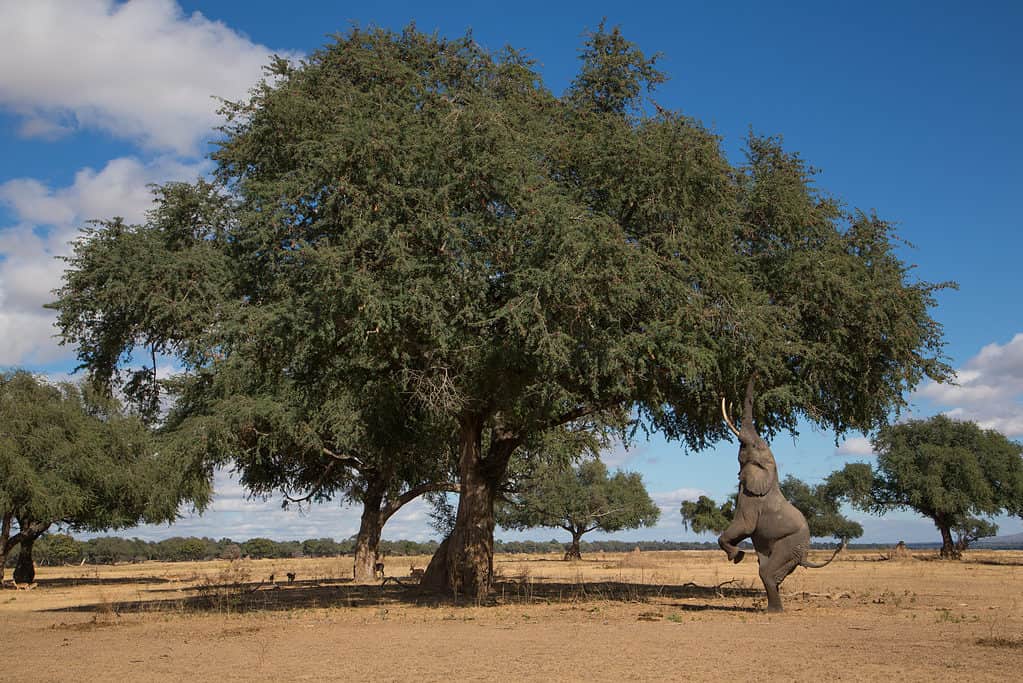
The ana tree is a thorn tree with deciduous blue-green leaves that fall in summer when water is scarce.
©Jez Bennett/Shutterstock.com
2. Baobab (Adansonia digitata)
The African baobab tree is native to the Africa continent where it’s often called the upside down tree due to its root-like crown.
Baobabs are water-storing trees with expanding trunks. They’re one of the longest-lived vascular plants that can live for thousands of years and reach 100 feet (30 meters) tall. They’re typically found in Namibia’s dry savannas, but if you spot a baobab, it means groundwater is nearby.
African baobabs dominate landscapes. They provide shelter, food, and water for many animals such as elephants who chew their soft outer bark, and they are revered by locals who attribute legends and superstition to their giant sizes.
Namibia is home to a giant baobab called the Ombalantu tree or the Tree of Life. It’s 92 feet (28 meters) tall with an 87 feet (26.5 meter) diameter trunk. It’s in Outapi, north Namibia and potentially 800 years old. In the past, it’s hollow trunk was used as a post office, chapel, and hiding place, but today it’s a tourist attraction.
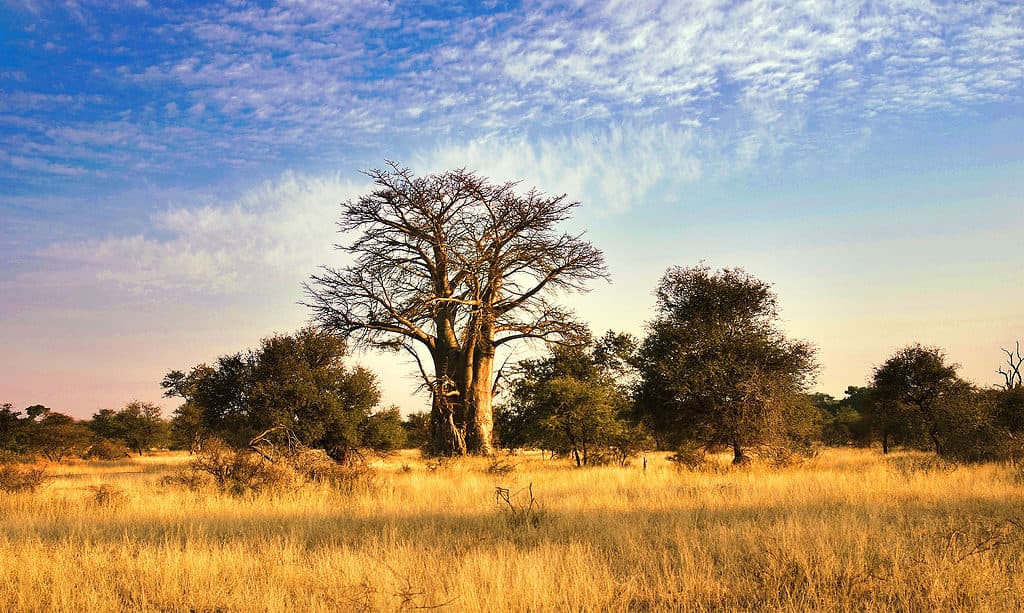
Baobabs are water-storing trees with expanding trunks.
©meunierd/Shutterstock.com
3. Bird plum (Berchema discolor)
Bird plum trees grow in forests and woodland habitats. They are not common trees, and the majority are in north-central Namibia.
This is a medium-sized tree that can reach 22-65 feet (7-20 meters) with a deciduous rounded canopy of green herringbone patterned leaves. Its bark is dark gray and peels off in strips and lumps. Although its timber is hard and attractive pale yellow, few trees are large enough to provide long planks of wood suitable for furniture making.
October to January is flowering time, so the bird plum produces numerous pollinator-friendly yellow-green flowers. These mature into small yellow drupe fruits that the locals collect to sell at market. Birds, monkeys and baboons also enjoy their juicy fresh taste!
The incredible tree native to Namibia is under protection and although it’s illegal to cut them down, bark stripping for dye sometimes kills them.
4. Black thorn (Acacia mellifera)
A blackthorn tree is a tough cookie. It can reach 29 feet tall (nine meters) and has an extensive underground root system that seeks out moisture.
It’s native to the majority of Africa, growing in most soils except sandy, desert ground. Black thorn lives up to its name with small hooked thorns growing in pairs along its branches.
Black thorn trees cluster in thickets and in some cases are so dense, it’s impossible to walk through. They can cope without water for long periods, sometimes shedding their opposite gray-green leaves to survive. Despite their name, and somewhat frightening appearance, black thorn trees have pretty cream-colored fragrant flowers that attract bees.
Flowers mature into brown papery seed pods. These pods disperse in the wind and quickly germinate to form even greater thickets.
Goats and cattle eat blackthorn leaves alongside camels, rhinos, and caterpillars. More recently, invasive thickets are cut for charcoal.
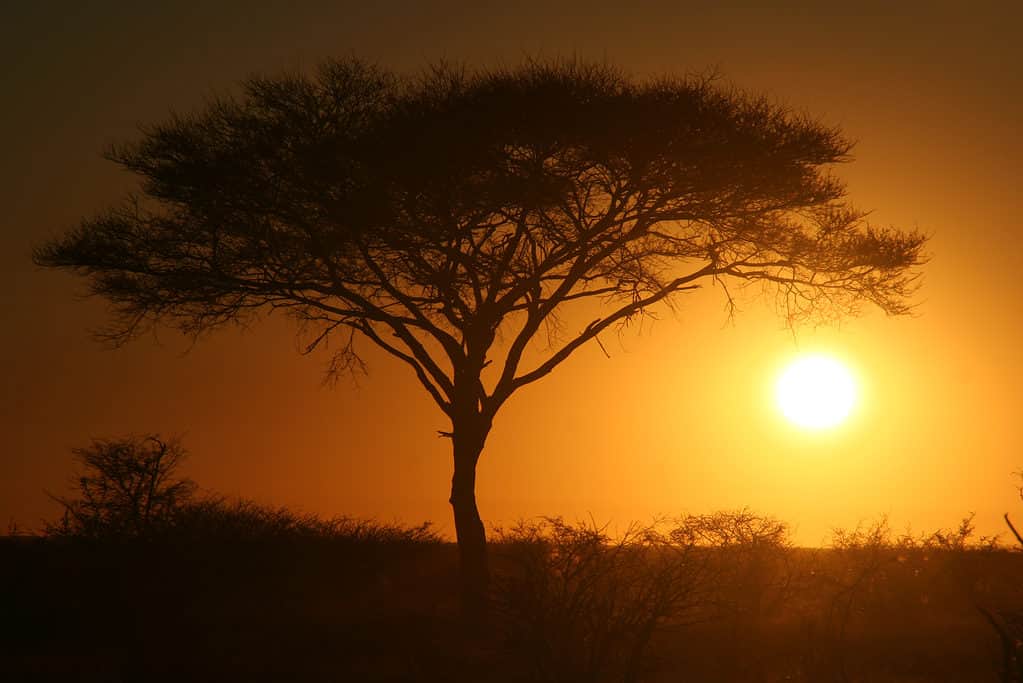
It’s native to the majority of Africa, growing in most soils except sandy, desert ground.
©Phillip van Zyl/Shutterstock.com
5. Burkea (Burkea Africana)
More commonly called wild syringa, the distinctive Burkea tree grows in Kalahari sands and northeastern Namibian forest edges.
It’s deciduous and reaches 39 feet (12 meters) tall on a slender trunk that forks into long branches around halfway up. Local hunters use its pulverized bark to paralyze fish!
Burkea’s most distinctive feature is its flat-topped crown, but its named wild syringa for the creamy white racemes of sweetly scented flowers that emerge after rain. Its pendulous racemes cascade 300 mm (30 centimetres) in length.
This is one of the few arid trees to produce a fall display. In the dry season, its leaves turn brown and red and then fall to the ground where they add essential nutrients to poor sandy soil.

More commonly called wild syringa, the distinctive Burkea tree grows in Kalahari sands and northeastern Namibian forest edges.
©Myriam Keogh/Shutterstock.com
6. Corky Monkey Orange (Strychnos cocculoides Baker)
An excellent name for an excellent tree! The corky monkey orange is indeed corky and it bears large green-orange fruits loved by monkeys.
This common tree grows up to 26 feet (eight meters) in the dry areas of southern Africa. This includes Namibia and is often alongside roads or in open forests such as the Springbok Flats.
It’s an evergreen with right-angled opposite green leaves and soft hairs, but it’s the bark that’s distinctive. It’s pale gray, deeply fissured, and corky. This corky trunk is fireproof because it provides a thick layer of insulation that doesn’t readily burn. Young twigs emerge greeny-yellow and some harden into thorns to form even more protection.
Its non-descript flowers mature into a woody-shelled green berry that turns orange as it ripens in December. Fruits look like small oranges and eventually measure up to 70 mm in diameter.
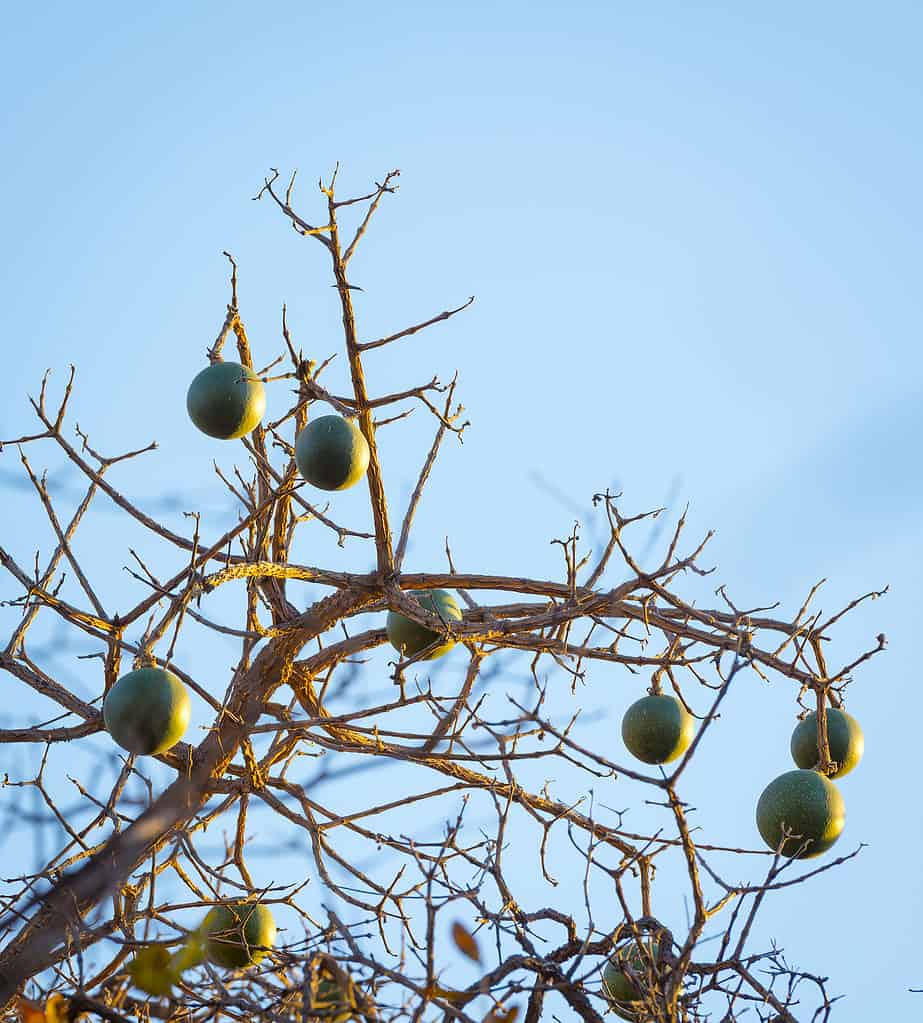
An excellent name for an excellent tree! The corky monkey orange is indeed corky and it bears large green-orange fruits loved by monkeys.
©THP Creative/Shutterstock.com
7. Kiaat (Pterocarpus angolensis)
Often called Africa teak, the kiaat is one of the most incredible trees native to Namibia and most of tropical Africa.
It’s huge, beautiful, and a resource for so many different wildlife species. Squirrels, charaxes butterfly caterpillars, monkeys, baboons, and elephants all love its foliage and seed pods. As such it’s a protected tree species in South Africa, but elephants still push them over to reach the foliage!
Kiaat is a deciduous tree that can reach 52 feet (16 meters) tall. It has dark brown bark and a large crown of alternate green foliage. Shortly before or after new foliage appears, fragrant yellow-orange flower panicles emerge up to six inches (20 centimeters) long. Once pollinated, they turn into pods resembling brown fried eggs.
African teak is cut for it’s attractive red hardwood timber. When its cut, red sap appears to bleed from the cuts, hence it’s alternate name blood wood tree.

Squirrels, charaxes butterfly caterpillars, monkeys, baboons, and elephants all love its foliage and seed pods. As such it’s a protected tree species in South Africa, but elephants still push them over to reach the foliage!
©NareshSharma/Shutterstock.com
8. Makalani palm (Hyphaene petersiana)
One of the many palms to grow in southern Africa, the makalani palm is native to Namibia and many sub-tropical low lying African countries.
It’s a distinctive palm with a slim single trunk, or sometimes several trunks, that emerge from ground level. The trunks are rough, bendy, and capable of reaching 59 feet (18 meters) tall, but most top out at 22-26 feet (7-8 meters). This palm has an extensive taproot to take advantage of groundwater.
Its fronds are typically palm-shape in a crown of dark green-gray on thorn-covered stalks. Its fronds are for weaving rugs and baskets, and its stalks for fence posts!
Usually situated around groves or ephemeral (this means short-lived flash floods or extensive rainstorm) rivers of northwestern Namibia. Makalani palms are essential breeding grounds for African palm swifts and rufous-tailed palm thrushes.
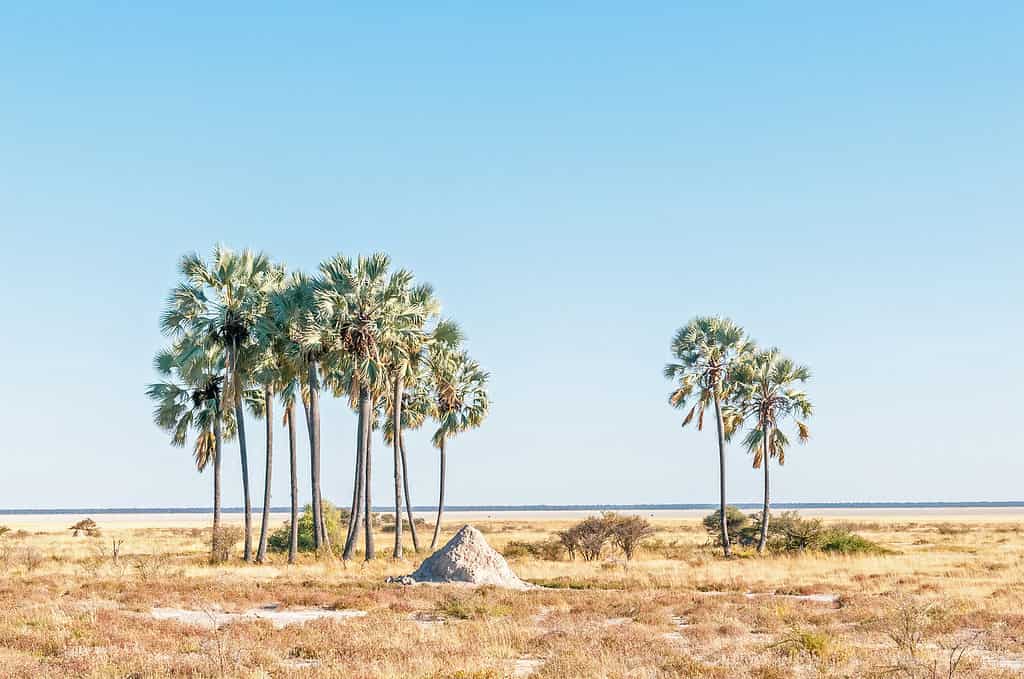
One of the many palms to grow in southern Africa, the makalani palm is native to Namibia and many sub-tropical low lying African countries.
©Grobler du Preez/Shutterstock.com
Up Next
Thank you for reading! Have some feedback for us? Contact the AZ Animals editorial team.

